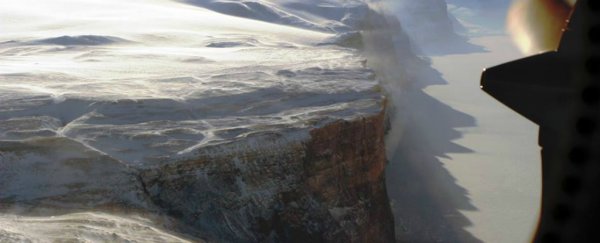New NASA photos have revealed an unusual crack forming across Greenland's Petermann Glacier, threatening to release a huge iceberg into the Arctic Sea. Worryingly, scientists aren't sure how the rift formed in the first place, or what it'll do next.
While cracks aren't an uncommon sight in ice sheets around the globe these days, this new discovery is alarming because it's formed in the middle of one of Greenland's glaciers, not at its edges, and it's not something scientists saw coming.
In fact, NASA scientists were first notified of the rift on Twitter last week, by Dutch scientist Stef Lhermitte from Delft University of Technology.
Lhermitte studies satellite remote sensing and recently stumbled across an image of what appeared to be a giant crack forming in the Petermann Glacier.
"I saw a small line and thought 'that seems new'," Lhermitte told Brandon Miller from CNN.
He went back through satellite images and found evidence of the crack as early as July 2016 - however, no one seemed to have noticed it as yet.
Unsure if the rift was the beginning of a new island forming, or simply the glacier splitting apart, Lhermitte put the question out to his Twitter community.
Is this recent internal crack in #Petermann glacier the prelude of a new @Petermann_ice island? 1/5 pic.twitter.com/V8qKF1MwmC
— Stef Lhermitte (@StefLhermitte) April 12, 2017
The images caught the attention of NASA's Operation IceBridge, an airborne survey team documenting changing polar ice, and they sent a flight out to check on the situation last week.
The new photos were released on the operation's Facebook page on Friday, and show the rift is even more serious than originally expected.
The crack is located on the glacier's floating ice shelf - which you can think of like the glacier's tongue that extends into the water from its mouth on land.
Around 70 km (43 miles) in length and 15 km (9.3 miles) in width, the Peterman Glacier's ice shelf is the largest in the Northern Hemisphere.
What's especially worrying is that the new rift has formed near the centre of the glacier's floating ice shelf.
This isn't where scientists expect to find new rifts - usually the cracks begin to form along the edges of a glacier, where the ice melts.
"Amazing to see a new crack forming and in a location well upstream of the present day calving front," Jason Box, a professor with the Geological Survey of Denmark and Greenland, who wasn't involved in the latest study, told Chris Mooney from The Washington Post.
He added that it could be a "prelude to further retreat".
That's because, generally speaking, the farther inland a crack forms, the more unstable it makes the glacier, as CNN reports.
Glacier ice shelves act as a buffer between the inland glacier and the open ocean - the less of a buffer there is, the quicker the land ice of the glacier is going to melt.
And with the Petermann Glacier holding back an estimated 30 centimetres (1 foot) of sea level rise, that's a pretty big deal.
Without further research, no one's quite sure how the rift started, but Eric Rignot, an earth scientist from NASA and the University of California at Irvine, told Mooney that the unusual crack could "indicate that the ice shelf has gotten too thin in the middle".
"The ice shelf is slowly but surely falling apart," he added.
Of added concern is the fact that the images also show the new rift getting close to an older crack. If the two meet, it could calve off a huge iceberg - something the glacier is no stranger to.
In 2010, an iceberg four times the size of Manhattan broke off the Petermann Glacier, and in 2012 a second iceberg around a quarter that size was also released.
But the good news is the new rift seems to getting close to a 'medial flowline', which is a flow of ice in the middle of the ice shelf that might slow the crack down somewhat and "exert a stagnating effect on the propagation of the new rift toward the older one," Operation IceBridge wrote on Facebook.
At this point, no one's sure how the crack will progress, but one thing's for certain, researchers are going to be keeping a close eye on it.
